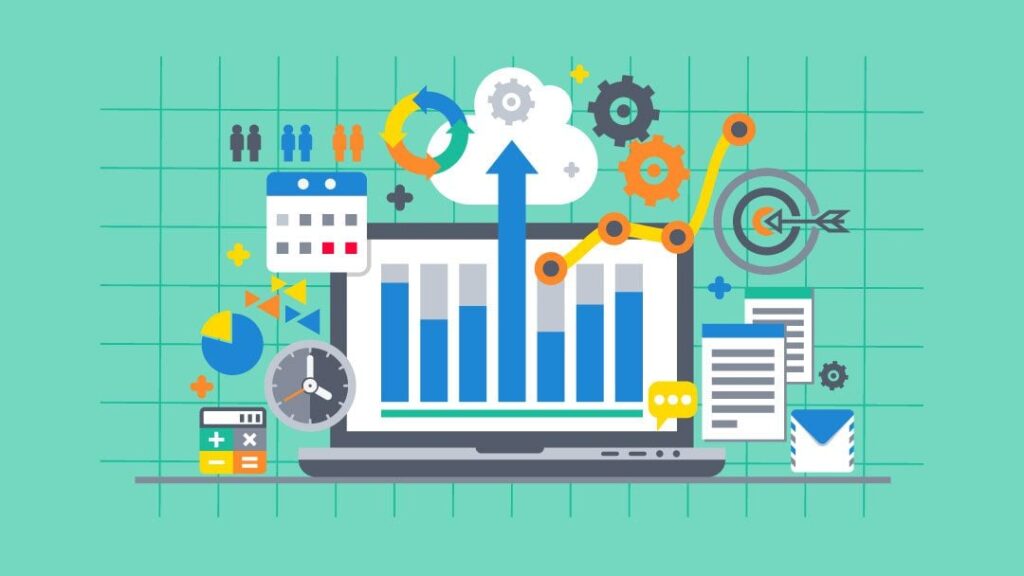
Marketing analytics is the practice of measuring, managing, and analyzing data from various marketing channels to optimize campaigns, drive growth, and improve ROI. It involves using tools and techniques to collect and analyze data from digital marketing channels such as social media, email, website, and advertising to gain insights into customer behavior, preferences, and trends.
This technique helps businesses to make data-driven decisions, identify opportunities, and improve performance. By analyzing data on customer behavior, market trends, and campaign performance, businesses can adjust their strategies, optimize their spending, and target their efforts more effectively to achieve their marketing goals.
Some common marketing analytics metrics include website traffic, conversion rates, customer lifetime value, return on ad spend (ROAS), customer acquisition cost (CAC), and customer retention rate. By tracking and analyzing these metrics, businesses can gain a better understanding of their customer’s needs and behaviors, identify areas for improvement, and optimize their marketing campaigns to achieve better results.
Importance of Marketing Analytics

Marketing analytics is important because businesses can gain valuable insights from it to make data-driven decisions, improve marketing performance, and drive growth. Here are some of the key reasons why marketing analytics is essential for businesses:
1. Understanding Customer Behavior
It helps businesses understand their customer’s behavior, preferences, and needs. By analyzing customer data from various channels, businesses can gain insights into how their customers interact with their brand, which products or services are most popular, and which channels are most effective at driving conversions.
2. Optimizing Marketing Campaigns
It allows businesses to measure and analyze the performance of their marketing campaigns, including their website, social media, email, and advertising efforts. By tracking metrics such as conversion rates, click-through rates, and engagement rates, businesses can identify areas for improvement and optimize their campaigns to achieve better results. Additionally, analyzing customer behavior and preferences can provide further insights for enhancing marketing strategies.
3. Improving ROI
It helps businesses measure the return on investment (ROI) of their marketing efforts. By tracking metrics such as customer lifetime value, customer acquisition cost, and revenue per customer, businesses can optimize their spending and maximize their ROI. Furthermore, analyzing customer segments and demographics can help businesses target their audience more effectively and allocate resources more efficiently.
4. Identifying Opportunities
It helps businesses identify new opportunities for growth and expansion. By analyzing market trends, customer behavior, and competitor strategies, businesses can identify new markets to target, new products to offer, and new channels to explore.
Marketing Analytics: How and Where to Start
Getting Started with marketing analytics can be overwhelming, especially if you are new to data analysis and don’t know where to begin. Here are some steps you can take to get started with marketing analytics:
1. Define Your Goals
The first step in implementing marketing Statistics is to define your goals. What do you want to achieve with your marketing efforts? Are you looking to increase website traffic, improve conversion rates, or drive sales? Clearly defining your goals will help you focus your efforts and measure your progress.
2. Identify Your Key Metrics
Once you have defined your goals, identify the key metrics you will use to measure your progress. Some common marketing Statistics metrics include website traffic, conversion rates, customer lifetime value, and return on investment (ROI).
3. Collect Data
You need to collect data from various sources, including your website, social media channels, email marketing software, and advertising platforms. Use tools such as Google Analytics, Facebook Insights, and email marketing software to collect data and track your metrics.
4. Analyze Your Data
Once you have collected your data, it’s time to analyze it. Use data visualization tools such as charts and graphs to make sense of your data and identify patterns and trends. Look for correlations between different metrics to identify areas for improvement.
5. Take Action
Based on your analysis, take action to optimize your marketing efforts. Make changes to your website, adjust your advertising campaigns, or tweak your email marketing strategy to improve your metrics and achieve your goals.
Summary
- We refer to the process of measuring, managing, and analyzing marketing performance data as marketing statistics.
- In this process, businesses must gather and analyze data from multiple marketing channels.
- The goal of marketing Statistics is to gain insights into customer behavior and preferences, campaign performance, and overall marketing ROI.
- Businesses may use marketing Statistics to make data-driven decisions to enhance their marketing tactics.
- Marketing Statistics helps businesses increase customer engagement and drive revenue growth.
- Marketing analytics can provide insights into areas such as customer demographics, customer journeys, marketing channels, and campaign performance. Additionally, businesses can use predictive analytics to forecast future trends and make data-driven decisions.
- Marketing Statistics tools include data visualization software, marketing automation platforms, and web analytics platforms.
- The use of marketing Statistics is becoming increasingly important as businesses rely more on digital marketing channels.
- Marketing statistics can provide useful data for optimizing marketing campaigns, improving customer targeting, and increasing customer retention.
- The insights gained from marketing Statistics can help businesses stay competitive and improve their bottom line.
FAQ
Q: What data sources can be used for marketing analytics?
A: Businesses can use various data sources for marketing analytics, such as website analytics, social media data, email marketing data, customer relationship management (CRM) data, and sales data. Furthermore, integrating data from multiple sources can provide a more comprehensive view of the customer journey and enhance the accuracy of the analysis.
Q: What are some common metrics used in marketing analytics?
A: Common metrics used in marketing analytics include conversion rate, customer acquisition cost (CAC), customer lifetime value (CLTV), click-through rate (CTR), bounce rate, and return on investment (ROI).
Q: What are some tools used for marketing analytics?
A: Tools used for marketing analytics include data visualization software, marketing automation platforms, and web platforms.
Q: How can marketing analytics be used to improve marketing campaigns?
A: Businesses can use marketing analytics to identify areas for improvement in their marketing campaigns, optimize their ad spend, improve targeting and personalization, and increase customer engagement and retention.
Q: How can businesses get started with marketing analytics?
A: Businesses can begin using marketing analytics by defining their goals, identifying key performance indicators (KPIs), selecting data sources, and implementing analytics tools and processes.


